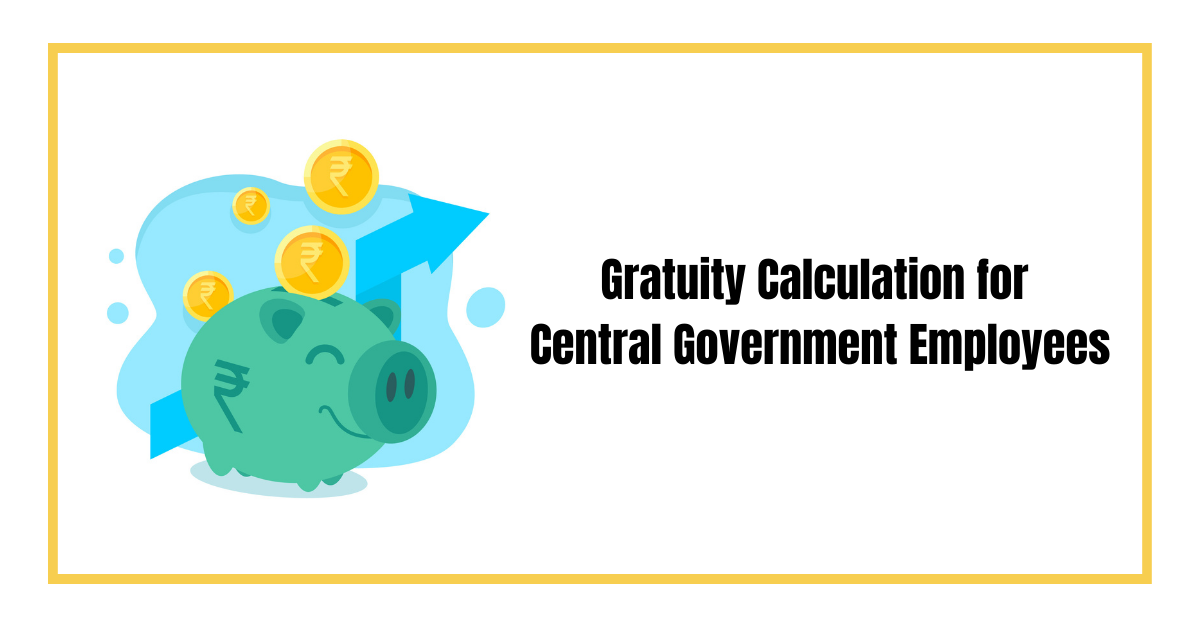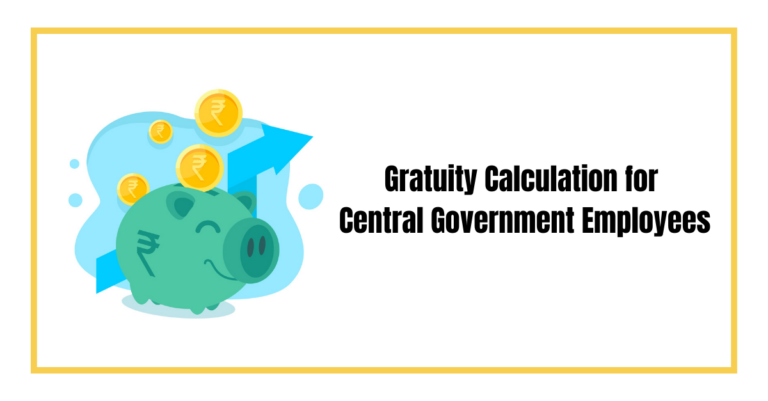Discover a simplified guide to gratuity calculation for Central Government employees. Uncover straightforward insights into factors influencing gratuity benefits.
According to the Payment of Gratuity Act 1972, gratuity is the lumpsum payment that employers are obliged to pay to those employees who have worked for their organizations for a continuous period of 5 years or more. It can be viewed as a token of appreciation for their long service and a benefits plan at the time of retirement. Let’s see about gratuity calculation for central government employees in this blog.
What is Gratuity in India?
Gratuity is a statutory benefit provided to employees in India as a token of appreciation for their long and meritorious service to an organization. Governed by the Payment of Gratuity Act of 1972, gratuity is a lump sum amount paid by employers to eligible employees upon their retirement, resignation, or death.
| The Payment of Gratuity Act sets the rules and regulations regarding the payment of gratuity, ensuring that employees receive a financial cushion in acknowledgement of their dedicated service. The Act outlines the eligibility criteria, calculation method, and other essential aspects related to gratuity. |
How Can a Gratuity Calculator Help You?
Calculating gratuity involves a formula based on the employee’s last drawn salary and the number of years served. A gratuity calculator simplifies this process, taking into account factors such as the basic salary and the dearness allowance to provide an accurate estimate of the gratuity amount.
Benefits of Using a Gratuity Calculator:
Accuracy: Avoid manual errors by relying on a systematic and accurate gratuity calculation tool.
Time-Saving: Quickly assess the gratuity amount without the need for complex manual calculations.
Planning: Facilitate financial planning for employees approaching retirement by providing them with a clear understanding of their gratuity entitlement.
What Are the Gratuity Rules?
Gratuity in 2023 is disbursed under the following circumstances:
- Superannuation: When an employee becomes eligible for superannuation.
- Retirement: Upon an employee’s retirement from active service.
- Resignation: In the event of an employee resigning from their position.
- Demise or Disability: If an employee passes away or is rendered disabled due to an accident or illness, gratuity becomes payable. In case of the employee’s demise, the gratuity amount is directed towards the nominee appointed by the employee.
Understanding the latest updates on the most recent regulations governing gratuity payouts is essential for both employers and employees to ensure compliance with the provisions outlined in the Gratuity Act.
Which Organization is Eligible for Gratuity?
The Payment of Gratuity Act of 1972 applies to employees engaged in various sectors such as factories, mines, oilfields, plantations, ports, railway companies, shops, or other establishments employing 10 or more individuals. Gratuity is a statutory benefit fully funded by the employer, and no portion of it is deducted from the employee’s salary.
Eligibility Criteria:
To qualify for gratuity under the Gratuity Act, an employee must meet the following criteria:
The employee should have completed a minimum of five full years of service with the current employer. However, exceptions exist in the cases of death or disability caused by an accident or illness. In such situations, gratuity is mandated to be paid.
Gratuity Calculation Formula
Gratuity is calculated on the basis of the last drawn salary, which includes the last drawn basic salary and the Dearness Allowance (DA), and the number of years of service.
S = last drawn basic salary plus DA
For example, if you have worked for a company for 30 years and your last salary including your DA was ₹25,000, then the minimum Gratuity you are entitled to receive will be,
Your Gratuity Amount = 30*25,000*15/26 = ₹4,32,692.30
This is the minimum gratuity amount that your employer is liable to pay. However, he can pay up to ₹10 lakhs as a mark of appreciation. If he wants to give any amount more than ₹10 lakhs, then that will be considered as ex-gratia or bonus.
In addition to that, while considering the number of years of service anything more than 6 months will be considered as one additional year of service, and for less than 6 months of service, that year will be excluded from the calculation.
Retirement Gratuity Calculation for Central Government Employees
The retiring Government servants are entitled to the retirement gratuity. Any central government employee, who has worked for a minimum period of 5 years, is eligible for a lump sum gratuity payment. The calculations for such gratuity amount are based on 1/4th of the Basic salary including the Dearness Allowance, as on their date of retirement. There is no minimum ceiling for this amount. The central government employees at the time of their retirement are eligible to receive 16 times their Basic pay including DA for their qualifying service of 33 years or more (as applicable). However, as per the new rule, this amount cannot be more than ₹20 lakhs.
Recent Changes in the Gratuity Rules
As a relief package for the central government employees, the union minister has announced a host of benefits. For nearly 52 lakhs central government employees and about 60 lakh pensioners the government has announced that it will restore Dearness Allowance (DA) proposed by the 7th pay commission and simplify the Dearness Relief benefit proposed by the 7th Central Pay Commission. There have been two major changes in the gratuity rules for the central government employees.
- Firstly, recently the government has announced that the gratuity upper ceiling will be raised to ₹20,00,000; and this applies to the private sector as well as central government employees. So, now central government employees can enjoy up to ₹20,00,000 tax-free gratuity benefits.
- The second announcement is related to DA which will be applicable to the pensioners who retired between the time period 1st January 2020 to 30th June 2021.
According to the existing Central Civil Services (Pension) Rules 1972, so far DA based on the date of retirement or death is counted for calculating the net payable gratuity amount. In addition to this, for calculating the net payable amount for leave encashment benefits, CCS (Leave) Rules 1972 says the basic pay and the DA as on the date of retirement/death will be considered.
Following the Covid-19 pandemic, to reduce the financial pressure on the government exchequer for the time being the Government of India took a decision to freeze DA and DR benefits. Nonetheless, they decided even though they will not be disbursing the amount right away, the GOI will continue to declare DA for the respective months. For example, GOI has declared 4% DA for the month of January to June 2020, 3% DA for the month of July to December 2020, and 4% cent DA for the month of January to June 2021.
However, such DA freezing has led to a lot of confusion among central government employees, especially pensioners. During the restoration of DA and DR benefits for the central government servants and pensioners, it was found that due to the DA freezing for the period 1st January 2020 to 30th June 2021, there is confusion while calculating the actual amount payable to the pensioners who have retired during that time. The government has declared that these pensioners will be eligible for gratuity and cash for leave based on only 17% DA.
The government of India has announced that all the pensioners who retired between the time period 1st January 2020 to 30th June 2021, will be eligible for the same gratuity and leave encashment benefits as they would have gotten without such freezing of DA.
The new order clarifies the following details of Dearness Allowance during that period:
| Retirement time | Dearness Allowance |
| 1st January 2020 to 30th June 2020 | 21 percent (17 + 4) |
| 1st July 2020 to 31st December 2020 | 24 percent (17 + 4 + 3) |
| 1st January 2021 to 30th June 2021 | 28 percent (17 + 4 + 3 + 4) |
It is also being decided that such enhanced DA will only be considered for gratuity calculation and leave encashment. The gratuity calculation for central government employees needs to consider the above-mentioned rate of DA for calculating the exact amount of gratuity that a central government employee will be entitled to receive at the time of retirement.
Income Tax & Exemptions on Gratuity
The tax treatment of gratuity depends on the category of the recipient.
Government employees, including those working for central, state, or local authorities, enjoy complete exemption from income tax on the gratuity amount they receive.
For eligible private sector employees whose employers fall under the Payment of Gratuity Act, the income tax exemption is calculated based on the least of the following three amounts:
- Rs 20 lakh
- The actual gratuity received
- The eligible gratuity amount
To illustrate, if an employer disburses a gratuity of Rs 12 lakh and, based on the gratuity calculation, the eligible amount is Rs 2,59,615, the tax exemption is determined by the minimum of these figures, i.e., Rs 2,59,615. Any remaining amount, in this case, Rs 9,40,385, is subject to taxation according to the recipient’s income tax slab.
It’s important to note that throughout one’s career, the maximum gratuity amount eligible for tax exemption cannot exceed Rs 20 lakh.
Along with these announcements, the GOI has also announced that from now on more than 60 lakh pensioners will be receiving their detailed pension slips via email, SMS, or WhatsApp. The GOI has directed respective banks to ensure this facility to promote the ‘Ease of Living’ of senior citizens, especially those who had been central government employees. This facility will come into effect on 1st July 2021. In addition to that, the government has taken the initiative to simplify the rules of family pensions applicable to central government employees.










